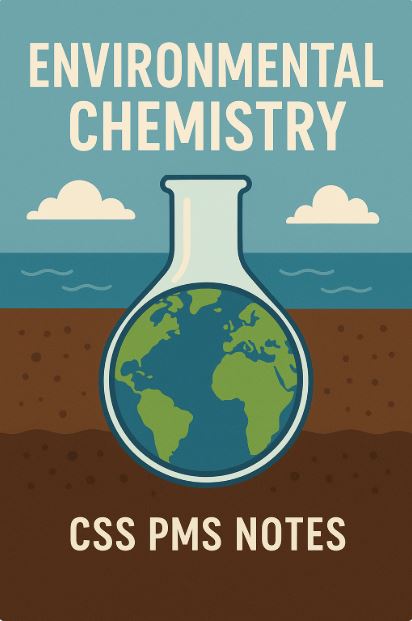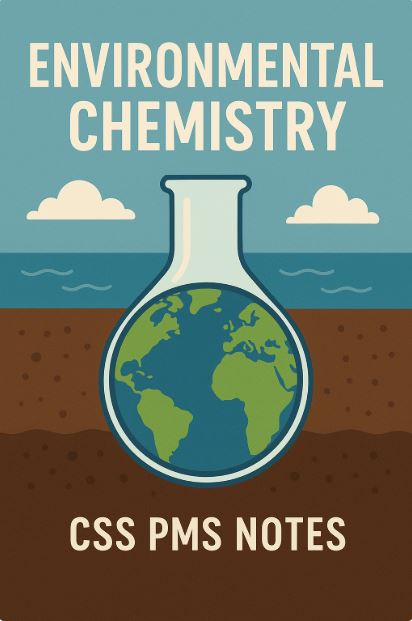Environmental Chemistry: Understanding the Chemistry of Our Planet

What is Environmental Chemistry?
Environmental chemistry is the study of chemical reactions that occur naturally on Earth. It focuses on how chemicals move, react, and change in the air, water, and soil.
In simple words, it’s about understanding how human actions and natural processes affect our environment through chemistry.
Example: When cars release gases, those gases react with oxygen and sunlight to form smog — that’s environmental chemistry in action.

Scope and Importance of Environmental Chemistry
Environmental chemistry is important because it helps scientists and governments:
- Detect pollutants in air, water, and soil.
- Predict chemical behavior in natural systems.
- Design cleaner and safer products.
- Control pollution and protect ecosystems.
Without it, we couldn’t track acid rain, smog, or toxic waste, nor find solutions to environmental problems.
Core Concepts in Environmental Chemistry
Environmental chemistry is based on four key pillars:
| Concept | Meaning | Example in Daily Life |
|---|---|---|
| Sources | Where chemicals come from | Factories releasing CO₂ |
| Reactions | How chemicals change | Formation of acid rain |
| Transport | How chemicals move | Wind spreading smoke |
| Fate | What finally happens | CO₂ dissolving in oceans |
These processes determine how a chemical affects the environment and living organisms.
Major Branches of Environmental Chemistry
- Atmospheric Chemistry – studies gases and particles in the air.
Example: How greenhouse gases trap heat and cause global warming. - Aquatic Chemistry – focuses on rivers, oceans, and groundwater.
Example: Dissolved oxygen levels in lakes that affect fish life. - Soil Chemistry – examines the reactions between soil minerals and chemicals.
Example: Pesticides and fertilizers changing soil quality.
Environmental Indicators
Environmental indicators show the quality of air, water, or soil. They help scientists measure pollution levels.
| Indicator | What It Measures | Why It Matters |
|---|---|---|
| DO (Dissolved Oxygen) | Oxygen in water | Low DO means aquatic life is in danger |
| BOD (Biochemical Oxygen Demand) | Organic load in water | High BOD = high pollution |
| COD (Chemical Oxygen Demand) | Oxygen needed to break chemicals | High COD shows chemical pollution |
| pH Level | Acidity of water/soil | pH below 6 harms aquatic life |
| TDS (Total Dissolved Solids) | Dissolved salts and minerals | High TDS makes water unsafe |
These are standard environmental indicators used globally for water and soil testing.
Source: U.S. Environmental Protection Agency (EPA)
Types of Contaminants
Contaminants are substances that are not naturally present or exist in harmful amounts.
They may or may not cause harm — but when they do, they’re called pollutants.
1. Chemical Contaminants
Include heavy metals like lead, mercury, and arsenic.
- Found in industrial waste, batteries, and paints.
- Example: Lead pipes contaminating drinking water.
2. Gaseous Contaminants
Include carbon monoxide, NOx, and sulfur dioxide.
- Cause smog and acid rain.
- Example: Car exhaust fumes.
3. Microbial Contaminants
Bacteria, viruses, or fungi that spread through water or food.
- Example: Cholera-causing bacteria in unclean water.
4. Nutrient Contaminants
Excess nitrates and phosphates from fertilizers cause eutrophication — algae growth in lakes that kills fish.
Analytical Techniques Used in Environmental Chemistry
Scientists use special instruments to detect even tiny amounts of pollutants.
- AAS (Atomic Absorption Spectroscopy): Detects metals like lead or mercury.
- GC/MS (Gas Chromatography-Mass Spectrometry): Finds organic pollutants.
- ICP-MS (Inductively Coupled Plasma Mass Spectrometry): Measures trace elements.
These methods are crucial for testing air, soil, and water quality accurately.
Source: ScienceDirect - Environmental Chemistry Overview
Applications of Environmental Chemistry
Environmental chemistry is used in daily life and industries to:
- Manage waste safely.
- Design eco-friendly materials and fuels.
- Protect groundwater and soil.
- Develop green chemistry solutions to reduce pollution at the source.
- Monitor industrial emissions and prevent chemical spills.
👉 Example: Engineers use environmental chemistry to clean up oil spills using biodegradable chemicals.
Environmental Chemistry and Green Chemistry
While environmental chemistry studies the effects of chemicals on nature,
green chemistry aims to prevent pollution by designing safer products and reactions. Both work together to protect our planet and promote sustainable development.
Challenges and Future Trends
- Growing industrial waste and plastic pollution
- Climate change increasing chemical reactions in the atmosphere
- New pollutants like microplastics and PFAS chemicals
- Need for advanced analytical methods and data-driven monitoring
Future focus is on AI-based sensors, bioremediation, and renewable energy chemistry.
Conclusion
Environmental chemistry connects science with sustainability. It helps us understand how every chemical reaction — from car exhaust to water purification — affects the planet.
By learning and applying its principles, we can build a cleaner, safer, and healthier future for all.
FAQs on Environmental Chemistry
Q1. What is environmental chemistry in simple words?
It’s the study of how chemicals move and react in air, water, and soil — and how they affect the environment.
Q2. What are the main types of contamination?
Chemical, gaseous, microbial, and nutrient contamination.
Q3. How is environmental chemistry used in daily life?
From checking drinking water quality to controlling car emissions — it’s part of everyday environmental protection.
Q4. What is the difference between contaminant and pollutant?
A contaminant may not always harm the environment, but a pollutant definitely does.
Q5. What is the future of environmental chemistry?
It focuses on cleaner production, renewable energy, and green chemistry to make Earth pollution-free.